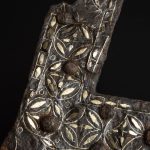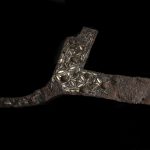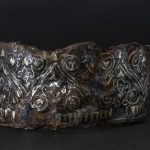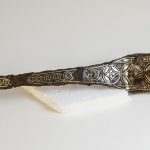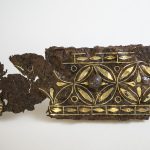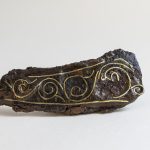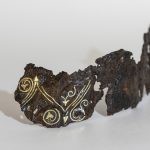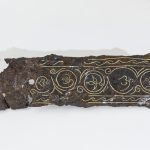Restoring the beauty of the Csillaghegy wagon burial finds
Press Statement
For immediate release
On the way to gleaming
Restoring the beauty of the Csillaghegy wagon burial finds
Budapest, 13 December 2018
Archaeologists of the Budapest History Museum and the Hungarian National Museum have found a unique Roman-period wagon burial in the 3rd District of Budapest on the site of the Csillaghegy Strandfürdő (Lido), in the vicinity of ancient Aquincum in Spring 2017. Although there are many Roman remains nearby, previous excavations in the immediate vicinity of the Lido had only found sites from the prehistoric, Hungarian conquest and Árpád dynasty periods. Prior to this excavation, archaeologists had only limited information on what remains they could expect to find there.
The grave was excavated between 29 March and 27 April 2017 by a partnership of the Budapest History Museum and the Hungarian National Museum, led by Zsolt Mráv and supported by archaeologists Lóránt Vass and László Schilling. Conservators of the two institutions worked together on conserving and removing the finds from the grave. Having increased the number of wagon burials found in and around Aquincum, the Csillaghegy wagon burial has enriched significantly our understanding of Imperial period wagon burials.
The site of the Lido belonged to the immediate surroundings, the extra-muros area of the Aquincum Civil Town. It lies a mere 2.2 km northwest of the former northern gate of the town, along the former north-south road that ran parallel to the limes road. Dotting the road were villa farms built typically during the late-2nd, early-3rd century. The villas were likely the centres of smaller estates occupied and cultivated by families of veterans or families who moved here from the east. The closest Roman building to the Lido (some 500 m as the crow flies) was the so-called Csillaghegy villa excavated partially in 2016.
“This building lies on a lot next to the Csillaghegy Lido, making it the closest known Roman site which we can potentially connect to the wagon burial,” said archaeologist Lóránt Vass of the Aquincum Museum.
What is new about the Csillaghegy wagon burial is that a plundered grave of a child was found next to it. Given their common orientation and vicinity, the two burials could not have been unrelated. “One of the problems of wagon graves is that only rarely can we connect a specific burial or person to them. The Csillaghegy wagon grave is one of the exceptions. Moreover, the age of the deceased youth is not only interesting, but also unusual. For now it is impossible to determine whether the youth was buried along with the wagon as the ‘main occupant’ of the grave, or if he was only buried near the pit with the wagon at a later time,” said archaeologist Zsolt Mráv of the Hungarian National Museum, a researcher of horse and wagon burials in Pannonia, who coordinated the excavation.
Also noteworthy, said Mráv, is the mode of the burial, for which this is the first known example. The four-wheel wagon containing a seat with back- and armrests was placed in a large, deep pit with the wheels in place, ready for the journey. After the wagon had been laid in the grave, the carcases of two draught horses were placed on top of as well as next to the wagon.
Undoubtedly, the most eye-catching detail of the Csillaghegy wagon was its exceptional ornamentation, making it one of the most beautiful wagons in burials excavated in Pannonia. Of the 14 bronze statuettes on the wagon four are identical pole tops with a gryphon in the middle flanked by a snake on either side. Seen as guardians and protectors against harm, gryphons appear frequently on ornaments of grave monuments but also furniture and armour. The dragon snakes flanking the gryphons can be identified most probably as basilisks known in Antiquity for their ability to kill from a distance even with their voice and gaze. The functional metal parts of the wagon, too, were richly decorated with metal inlays, which complemented the ‘gallery of statues’ at the back of the wagon. The gallery’s ten figural bronze statuettes depict Dionysus and his merry entourage. The central figure of the composition was the deity himself, holding a cluster of grapes and a vessel from which he poured wine, lapped up by the tigers that the deity himself had domesticated. One of Dionysus’ magical traits was his ability to tame fearsome wild cats into loyal pets and to have them draw his carriage. The depiction of the Dionysus myth on the wagon was adapted to the native Eraviscus elite’s view of the afterlife. In the wagon burials that included figural statues Dionysus and his entourage were always depicted, which is no coincidence. After all, the deity offered his followers a happy afterlife, reminiscent of a golden age, which closely resembled one of the Celtic views on the afterlife.
This was the first time that an excavation has found the body of a Roman wagon; so following the lengthy conservation process, it will be possible to reconstruct almost every detail of the Csillaghegy wagon. Following restoration, the Csillaghegy wagon’s parts and their reconstructions are expected to be exhibited at the Aquincum Museum within the next two years.
For more information on the excavation visit: www.aquincum.hu, www.mnm.hu, and www.magyarmuzeumok.hu.
Photographs (by Nóra Szilágyi):
Contacts: Zsanett Abonyi, Museum Education Unit, Aquincum Museum
+36306918620; abonyi.zsanett@aquincum.hu
